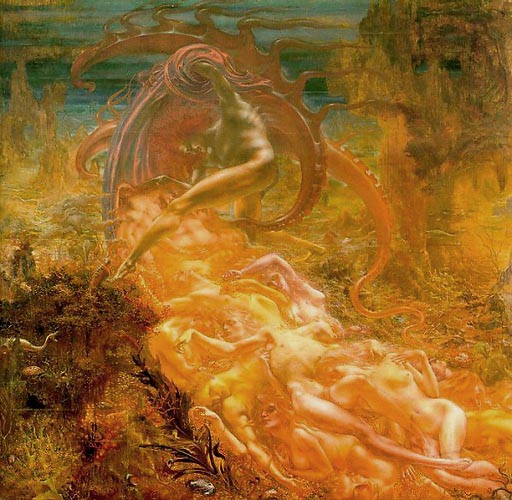
Les trésors de Satan - Jean Delville
(Royal Museums of Fine Arts of Belgium Catalogue, 1895)
Delville emphasized the perils of materialism and sensuality in an image of souls ensnared by the tentacles of Satan: The Treasures of Satan, 1894, Royal Museums of Art, Brussels. In this work the voluptuous sinners are not so much being punished as they are being trapped at a low level of spiritual evolution. The depths of the sea corresponds to their low development. They are trapped by being fixated on material treasures: jewels, pearls, and sensuality. They are also the "Treasures of Satan", being trapped by him. Satan, although handsome and graceful, is himself a low-level being, as revealed by his tentacles. His physical form reveals his spiritual nature.
Here the artist depicts Satan with a wild, fiery head of hair and huge red tentacles instead of wings. Scarlet waves surround his left arm, as he presides over a river of unconscious men and women. The nude bodies of these figures appear orange and yellow in reproductions, but in the original they are a subtle mixture of acid pinks and yellows, highlighted with touches of green. They lie transfixed in the centre of a luxuriant coral reef, surrounded by coins, jewels and strange fish. Beyond the reef one can see vast vistas filled with jagged rock formations, and painted in shades of orange, yellow and brown. Though the full interpretation is again left to the viewer, it clear that Satan’s Treasures is not a traditional vision of hell. What might have inspired this unusual image? It reveals a fascination with decadence and the erotic which was typical of Péladan and the period in general. At the same time, there is probably an underlying theme of initiation.
It was well known that Delville was a great admirer of Edouard Schuré’s The Great Initiates, and it could well be that Satan’s Treasures is inspired by an episode from the Initiation of Isis in Schuré’s book. In the relevant scene, Schuré describes the novice’s failure of an early test, the temptation of the senses. Wrapped in a dream of fire, the novice becomes drunk with the heavy perfume of a seductive woman, and later falls asleep, after wildly satisfying his desire. This failure is described by his hierophant as a fall into the abyss of matter.
Delville’s vast undersea world, ruled by Satan, is almost certainly an image of the material abyss. Satan, lord of the physical realm, presides over its sleeping inhabitants. Wrapped in delusion, the dreaming men and women are mersmerised by Satan’s spell, and trapped by their own desires. Satan’s “treasures” include not only their sensuality, but also their attraction to worldly riches, represented by the pearls, coins and corals which surround them. Above all, the entranced people themselves are the treasures of Satan.
Satan presides over an abysmal zone, an ambiguous universe, where fire weds water. His wings have metamorphosed into tentacles which wrap around his prey - subjugated bodies eraptured by gold, diamonds and pearls. In the reflection of the flames, fish thread through algae, the surrealism, almost akin to that evoked by the works of Heironymus Bosch. The oeuvre is a jubilant exultation of the perverse beauty of the devil. On an aesthetic level, the work is both academic and resolutely reactionary. The oeuvre is decorative and at the same time avant garde of the symbolist movement.
Symbolism is one of the most important and most significant pictorial movements, marking undeniably the arts and literature of the late nineteenth century. Its main goal was subversion, not only in the themes represented but also in the media used. Indeed, the Symbolist painters experimented with a lot of new techniques and supports, from wax to watercolour, from engraving to pastel, from charcoal to lithographs.
The Symbolist movement, rich and diverse, initiated the Avant-garde of the twentieth century and announced some other movements such as Orphism and Surrealism.
~ * ~